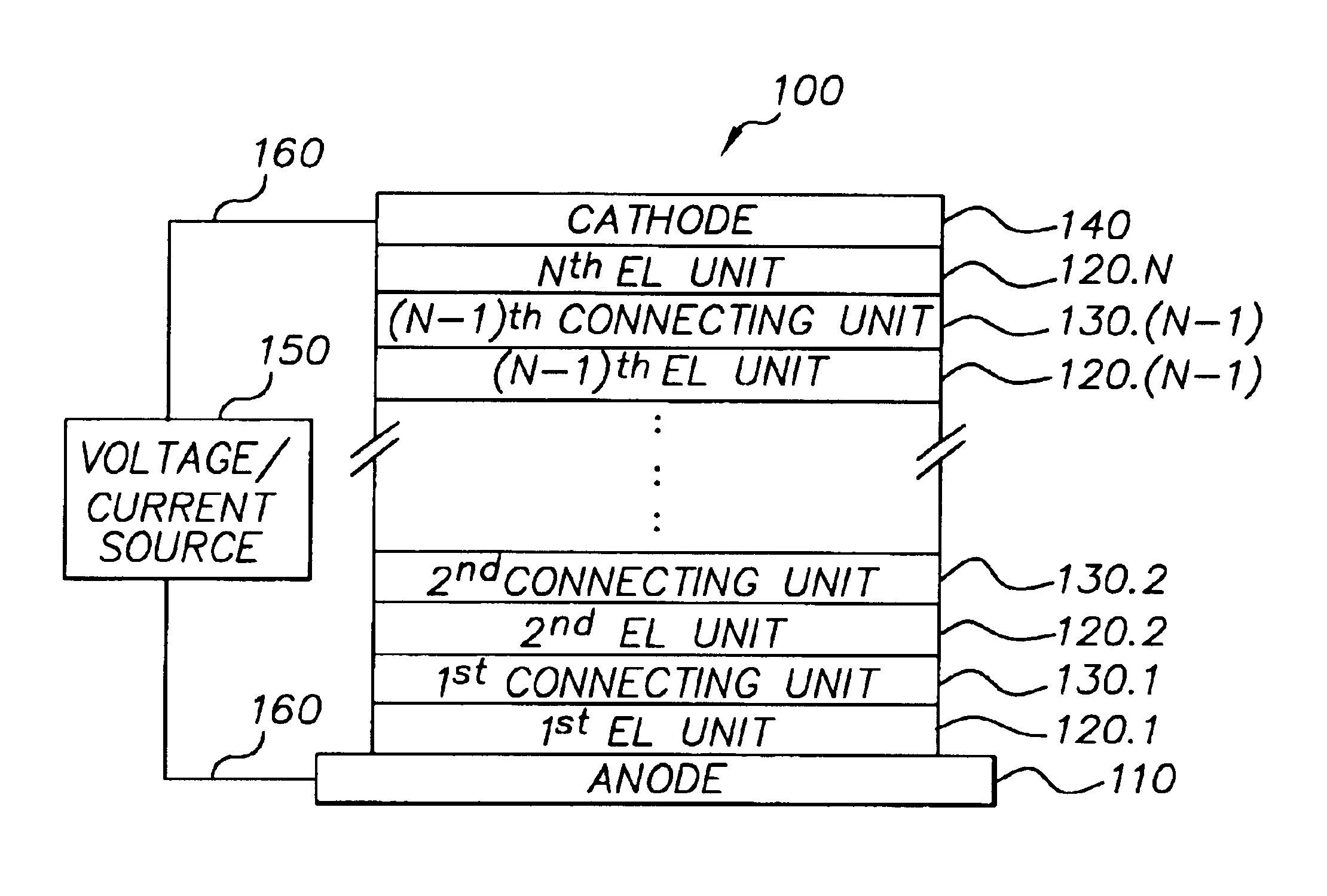Cascaded organic electroluminescent device having connecting units with N-type and P-type organic layers
- Summary
- Abstract
- Description
- Claims
- Application Information
AI Technical Summary
Benefits of technology
Problems solved by technology
Method used
Image
Examples
example 1 (
Conventional OLED—Comparative)
[0152]The preparation of a conventional non-cascaded OLED is as follows: A ˜1.1 mm thick glass substrate coated with a transparent ITO conductive layer was cleaned and dried using a commercial glass scrubber tool. The thickness of ITO is about 42 nm and the sheet resistance of the ITO is about 68 Ω / square. The ITO surface was subsequently treated with oxidative plasma to condition the surface as an anode. A layer of CFx, 1 nm thick, was deposited on the clean ITO surface as the HIL by decomposing CHF3 gas in an RF plasma treatment chamber. The substrate was then transferred into a vacuum deposition chamber for deposition of all other layers on top of the substrate. The following layers were deposited in the following sequence by sublimation from a heated boat under a vacuum of approximately 10−6 Torr:[0153](1) a HTL, 90 nm thick, consisting of NPB;[0154](2) a LEL, 20 nm thick, consisting of Alq host doped with 1.0 vol. % C545T;[0155](3) an ETL, 40 nm th...
example 2 (
Inventive)
[0160]The preparation of a cascaded OLED with two EL units is as follows: A ˜1.1 mm thick glass substrate coated with a transparent ITO conductive layer was cleaned and dried using a commercial glass scrubber tool. The thickness of ITO is about 42 nm and the sheet resistance of the ITO is about 68 Ω / square. The ITO surface was subsequently treated with oxidative plasma to condition the surface as an anode. A layer of CFx, 1 nm thick, was deposited on the clean ITO surface as the HIL by decomposing CHF3 gas in an RF plasma treatment chamber. The substrate was then transferred into a vacuum deposition chamber for deposition of all other layers on top of the substrate. The following layers were deposited in the following sequence by sublimation from a heated boat under a vacuum of approximately 10−6 Torr:[0161](1) a first HTL, 60 nm thick, consisting of NPB as a spacer between transparent anode and the first EL unit;[0162](2) a HTL, 30 nm thick, consisting of NPB;[0163](3) a ...
example 3 (
Inventive)
[0178]A cascaded OLED with three EL units was fabricated as the same as Example 2 except that after step (9) in Example 2, steps (5) to (9) are repeated once to add one more connecting unit and one more EL unit, followed by steps (10) and (11).
[0179]After the deposition of these layers, the device was transferred from the deposition chamber into a dry box for encapsulation. The completed device structure is denoted as
ITO / CFx / NPB(60) / EL / CU / EL / CU / EL / Alq(30) / Mg:Ag.
[0180]In this cascaded OLED, the same as )in Example 2, the connecting unit has a resistivity higher than 10 Ω-cm and an optical transmission higher than 90%. The peak emission wavelength λ from each LEL is 524 nm. S3=S3,O=95 nm, S2=1.01×S2,O=362 nm, and S1=1.02×S1,O=1.02×619=629 nm. The optical distances from each emitting central plane to the reflective Mg:Ag cathode have been optimized. Moreover, the physical spacing between each of the emitting central planes is 150 nm, which is corresponding to an optical dista...
PUM
 Login to View More
Login to View More Abstract
Description
Claims
Application Information
 Login to View More
Login to View More - R&D
- Intellectual Property
- Life Sciences
- Materials
- Tech Scout
- Unparalleled Data Quality
- Higher Quality Content
- 60% Fewer Hallucinations
Browse by: Latest US Patents, China's latest patents, Technical Efficacy Thesaurus, Application Domain, Technology Topic, Popular Technical Reports.
© 2025 PatSnap. All rights reserved.Legal|Privacy policy|Modern Slavery Act Transparency Statement|Sitemap|About US| Contact US: help@patsnap.com



